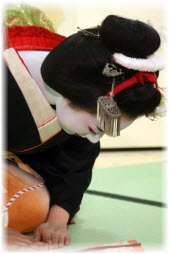You Got It!
The Meaning of Hin: Kendo with Hin?
Off the top of my head, it means "quality". Kendo with quality. It sounds good enough but I want to dig the meaning a little bit more deeply.
When we say "He/she has hin", we mean he/she does not say anything rude and/or disgusting.
He/she has this quality that attracts others as a human. His/her behaviours are somehow elegant.
I will give you an example of "hin".
One day, this great kabuki performer Danjuro Ichikawa (the 11th) saw a gentleman walking down the street when he was in a taxi.
Danjuro stopped the taxi and said, "Who the heck is he? The way he walks is beautiful."
 This picture is not related to kabuki. It is a maiko bowing
This picture is not related to kabuki. It is a maiko bowing* Danjuro Ichikawa is a stage name of kabuki that has been inherited from one generation to another. It goes back to 17th century. Now we have the 12th Danjuro.
Anyway, this walking guy was the late Moriji Mochida sensei (10th dan). Mochida sensei caught the famous kabuki actor’s eye just by his walk.
And Mochida sensei apparently used to say,
"We are not in Sengoku era (Warring States Period in Japan, 1493 (1467)-1573) anymore. Kendo-ka should not be strong and aggressive. Kendo-ka in our era should be strong with hin."
Character for hin is used to express, valuable characteristics/personality (hin-kaku) and elegance/dignity (hin-i).
So if our kendo is just aggressive and violent, we call it kendo withouthin. Hin is very important in kendo.
I must tell you this though. We, humans, have different developmental phases. We cannot just achieve this high quality kendo. Depending on characteristics of people, we really have to work on our kendo quality.
Unless we are born with this "hin", we should strive to get there. I do not mean it is OK to be aggressive but there is a phase of being aggressive or competitive, especially when we are young.
It is normal but we should know that we are not living in a war period and the purpose of kendo is not to defeat others but unwanted behaviour/thoughts in ourselves.
Without knowing the purpose of kendo, we often lose our way. That is why we have to know the concept and purpose of kendo first.
